Developing a vaccine against multiple psychoactive targets: a case study of heroin
- PMID: 22229311
- PMCID: PMC3327724
- DOI: 10.2174/187152711799219316
Developing a vaccine against multiple psychoactive targets: a case study of heroin
Abstract
Heroin addiction is a wide-reaching problem with a spectrum of damaging social consequences. Currently approved heroin addiction medications include drugs that bind at the same receptors (e.g. opioid receptors) occupied by heroin and/or its metabolites in the brain, but undesired side effects of these treatments, maintenance dependence and relapse to drug taking remains problematic. A vaccine capable of blocking heroin's effects could provide an economical, long-lasting and sustainable adjunct to heroin addiction therapy without the side effects associated with available treatment options. Heroin, however, presents a particularly challenging vaccine target as it is metabolized to multiple psychoactive molecules of differing lipophilicity, with differing abilities to cross the blood brain barrier. In this review, we discuss the opiate scaffolding and hapten design considerations to confer immunogenicity as well as the specificity of the immune response towards structurally similar opiates. In addition, we detail different strategies employed in the design of immunoconjugates for a vaccine-based therapy for heroin addiction treatment.
Figures

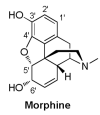
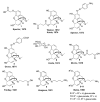


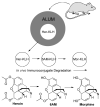

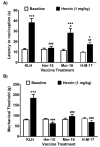

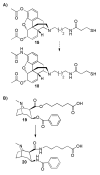
Similar articles
-
A vaccine strategy that induces protective immunity against heroin.J Med Chem. 2011 Jul 28;54(14):5195-204. doi: 10.1021/jm200461m. Epub 2011 Jun 30. J Med Chem. 2011. PMID: 21692508 Free PMC article.
-
Dynamic vaccine blocks relapse to compulsive intake of heroin.Proc Natl Acad Sci U S A. 2013 May 28;110(22):9036-41. doi: 10.1073/pnas.1219159110. Epub 2013 May 6. Proc Natl Acad Sci U S A. 2013. PMID: 23650354 Free PMC article.
-
Synthesis and immunological effects of heroin vaccines.Org Biomol Chem. 2014 Oct 7;12(37):7211-32. doi: 10.1039/c4ob01053a. Org Biomol Chem. 2014. PMID: 24995943 Free PMC article.
-
Vaccines against morphine/heroin and its use as effective medication for preventing relapse to opiate addictive behaviors.Hum Vaccin. 2009 Apr;5(4):214-29. doi: 10.4161/hv.5.4.7556. Epub 2009 Apr 8. Hum Vaccin. 2009. PMID: 19242094 Review.
-
Neurobiology of addictive behaviors and its relationship to methadone maintenance.Mt Sinai J Med. 2000 Oct-Nov;67(5-6):375-80. Mt Sinai J Med. 2000. PMID: 11064487 Review.
Cited by
-
Synthesis of Potential Haptens with Morphine Skeleton and Determination of Protonation Constants.Molecules. 2020 Sep 2;25(17):4009. doi: 10.3390/molecules25174009. Molecules. 2020. PMID: 32887468 Free PMC article.
-
A Stable Heroin Analogue That Can Serve as a Vaccine Hapten to Induce Antibodies That Block the Effects of Heroin and Its Metabolites in Rodents and That Cross-React Immunologically with Related Drugs of Abuse.J Med Chem. 2018 Jan 11;61(1):329-343. doi: 10.1021/acs.jmedchem.7b01427. Epub 2017 Dec 29. J Med Chem. 2018. PMID: 29236495 Free PMC article.
-
Levels of heroin and its metabolites in blood and brain extracellular fluid after i.v. heroin administration to freely moving rats.Br J Pharmacol. 2013 Oct;170(3):546-56. doi: 10.1111/bph.12305. Br J Pharmacol. 2013. PMID: 23865556 Free PMC article.
-
Mass Spectrometric Imaging of the Brain Demonstrates the Regional Displacement of 6-Monoacetylmorphine by Naloxone.ACS Omega. 2020 May 27;5(22):12596-12602. doi: 10.1021/acsomega.9b03570. eCollection 2020 Jun 9. ACS Omega. 2020. PMID: 32548443 Free PMC article.
-
A computational strategy for finding novel targets and therapeutic compounds for opioid dependence.PLoS One. 2018 Nov 7;13(11):e0207027. doi: 10.1371/journal.pone.0207027. eCollection 2018. PLoS One. 2018. PMID: 30403753 Free PMC article.
References
-
- Wright CRA. XLIX.-On the action of organic acids and their anhydrides on the natural alkaloids. Part I. Journal of the Chemical Society. 1874;27:1031–1043.
-
- Dott D, Stockman R. The chemistry and pharmacology of some of the morphine derivatives. Yearbook of Pharmacy. 1888:349–355.
-
- Stockman R, Dott D. Report on the pharmacology of morphine and its derivatives. Brit Med J. 1890;ii:189–192.
-
- von Mering J. Physiological and therapeutic investigations on the action of some morphia derivatives. The Merck Report. 1898;7:5–13.
-
- Sneader W. Drug prototypes and their exploration. Chichester; Wiley: 1996. pp. 185–187.
Publication types
MeSH terms
Substances
Grants and funding
LinkOut - more resources
Full Text Sources
Medical
